Description of Karelian birch and its application
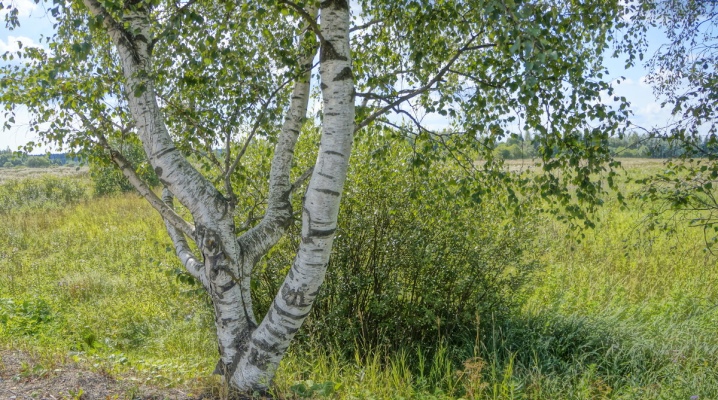
For production, as well as artistic creation related to wood processing, even trunks with minimal deformation are considered canonical. That is, the Karelian birch cannot be distinguished in this sense. Moreover, this breed is one of the most valuable. This is where flaws become a beneficial feature. Due to them, the wood acquires a marble texture, amazing and unsurpassed.
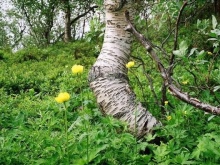
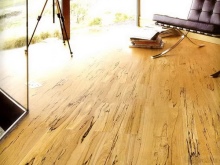
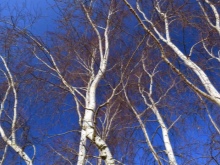
general information
Even during the reign of Catherine II, forester Fokel explored the forests of the north-west of Russia. There he found trees that he had never seen before. At first glance, it is an ordinary birch, but from the inside it seems that it is not a tree in it, but a true marble.
In 1857, the Russian scientist Merklin called the breed "Karelian birch" (at the place of discovery).
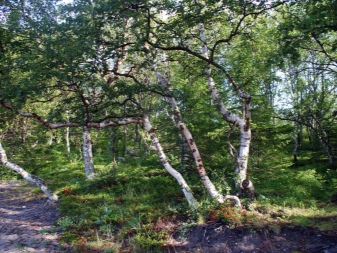
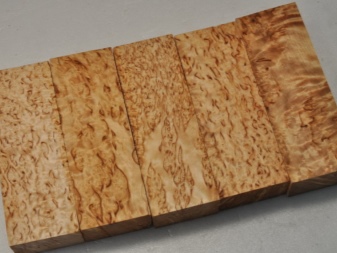
Appearance
It is a type of drooping birch, which has thickenings on the table (mouthpieces) and a tangled twisted texture. But, the main thing is that the Karelian birch has a unique pattern on the saw cut, which is obtained as such due to the interweaving of the fibers. Its wood is very hard and tough. The drooping birch cannot boast of this.
In any description it will be said that it grows scattered, if in groups, then small. Does not form thickets. Can be a tree or shrub from 5 to 20 m in height. Both giant bushes and dwarf bushes are found in nature. The crowns of trees are sparse, ragged shapes.

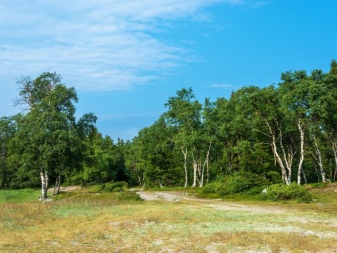
Botanical Description:
- deciduous tree;
- average trunk diameter - 40 cm;
- Karelian birch flowers are inconspicuous, collected in inflorescences;
- immature male earrings remain on the tree in the winter, while female ones appear in the spring;
- small winged seeds will mature at the end of summer;
- the leaf plate has a triangular shape, the base is wide, the apex is wedge-shaped, the edge is double-toothed.
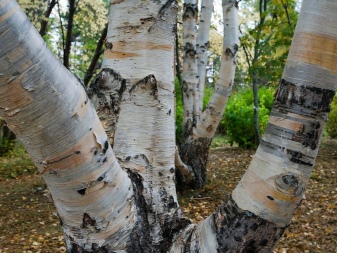
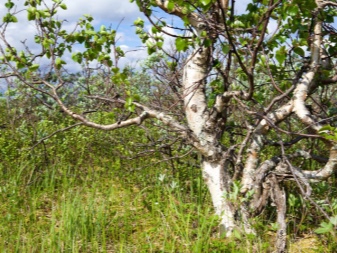
The main feature of the Karelian birch is a pitted, very dense wood. On a cut of the massif, one can see chaotic dark internal inclusions and compacted grooves located along the entire perimeter. Caps also make the birch pattern "marbled".
The most decorative stem part is considered to be attached, there are many seals. The higher the tree, the less its relief. The bark of the Karelian tree is coarser, in young trees it is reddish-brown. A light birch bark layer appears only in a tree that is already 4 years old. And over time, this layer will be easily separated by long ribbons.
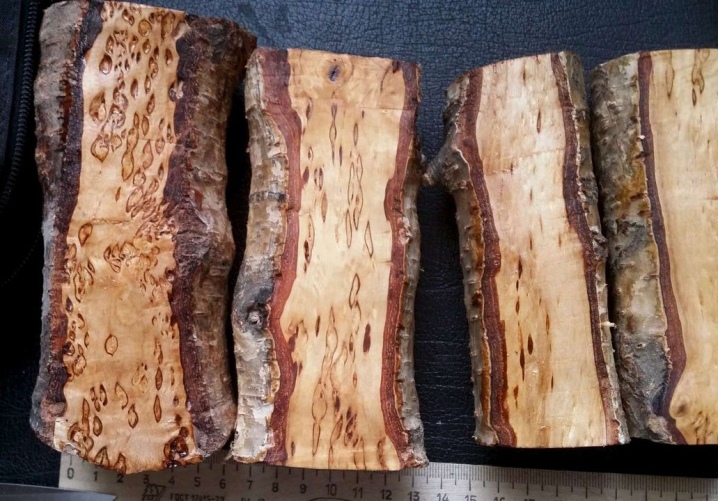
Wood properties
The tuberosity of the trunks creates a special patterned wood. The annual layers of this wood are bent in waves, the fibers are multidirectional, and the core rays grow into the soft tissue. The wood texture has a lot of curliness and dark inclusions, up to contrasting ones. It must be said that the fibers, as well as their sizes and the wood pattern itself, are always different. They are distinguished by color, length and width. Fibers are visualized with curved lines and irregular shapes - a miraculous imprint is formed on the cut of a tree, worthy of an artistic brush.
If in the center of the trunk it is possible to find curliness close to the bark, this is considered good luck. More precisely, if there is a twisted pattern along the entire trunk of the tree, this is very much appreciated in woodworking.
Features of wood:
- curls and plexuses of fibers form special shine, rays and spots that really look like marble in the light;
- yellow, brown, pink, milky shades - here is the color palette of the Karelian birch;
- the weight of this wood exceeds the weight of common birch by 30%.
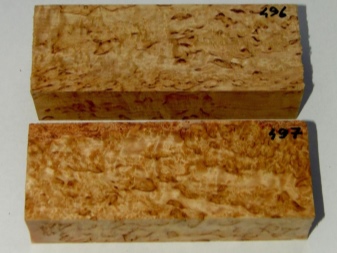
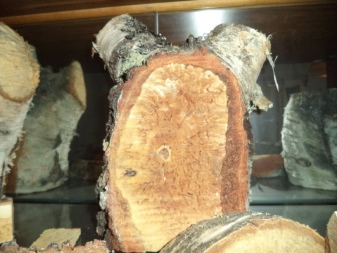
As for the mechanical properties, they have not yet been 100% studied. But, for example, it is known that the resistance to compression depends on how the fibers are arranged. The density of the wood is high, the resistance to static bending is low. The cracking properties are very high. The more sinuous a particular tree is, the sooner it will crumple.
There are several versions why the patterns of the Karelian birch are so fancifully formed. The following is considered a popular idea: pathogenic microflora, it's about it. However, there are also significant arguments against - a healthy tree does not become infected with a rootstock. And the researchers did not identify those organisms that could leave such drawings. It is believed that the cambium dying off is responsible for the patterns; in some zones it weakens its activity. And the hormone heteroauxin is also "blamed" for this, which, when increased, can give such a pattern, regulating the level of sucrose.
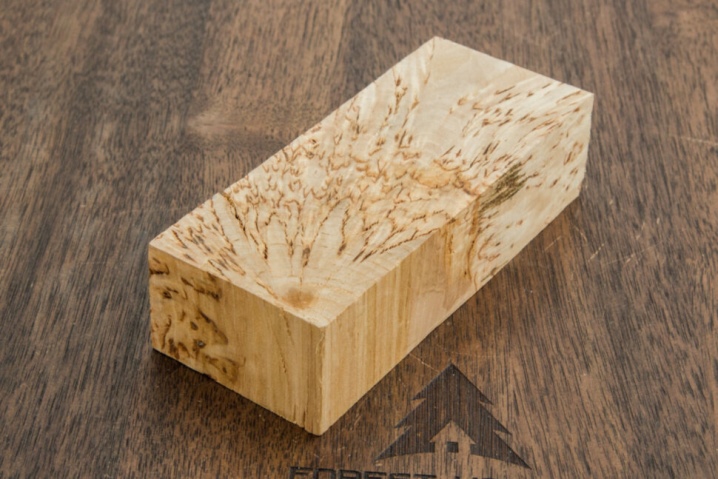
Growing regions
The main region is the northwestern part of Russia. Birch grows in Karelia, Leningrad, Yaroslavl, Kaluga, Bryansk, Vladimir regions. You can meet her in the Baltics, Belarus, the Scandinavian countries, in Ukraine. Occasionally, you can find Karelian birch in the south of the Carpathians, even less often in Poland and Germany.

Varieties by trunk type
The Karelian birch has rivals - ice and far-Karlian. The latter is a type of dangling birch, and is known primarily for its very beautiful dissected leaves. But Karelian birch also offers variety within the species. For example, by the type of trunk.
- Bushy... Such trees do not have an evenly pronounced axis, because in the process of growth, the trunk manages to disintegrate into side branches. It happens that instead of the main trunk, both vertical shoots and those that grow downhill develop powerfully. In any case, the root part of the trunk will be especially developed. In a bushy birch, the shoots end not with an axillary bud, but with two or three adjacent buds, forming a forked branching. And this type of branching (if, of course, lighting and free arrangement allows) reveals the valuable features of the tree. The bushy birch near the end has the most attractive wood. But in nature there is little of it, the output of wood will be small, because in industry it is actually not used.
- Short-barreled... The trunk of this variety is noticeably shorter, the height, shape and structure of the crown also differ. The crown has a wide spreading, it is round, there are many leaves. The main axis of the tree is replaced by several equally branched thick branches. There is a reason to harvest this type of Karelian birch: from the lower trunk part, you can take, albeit short, but graceful ridge texture.
- High-barreled... This plant has normal (or nearly normal) stem height. That is, it almost does not differ from drooping birch. The tree is well cleared of twigs, and its tapering is normal. From this variety, it is possible to obtain logs reaching 4-5 meters. And it will be a truly valuable asset.
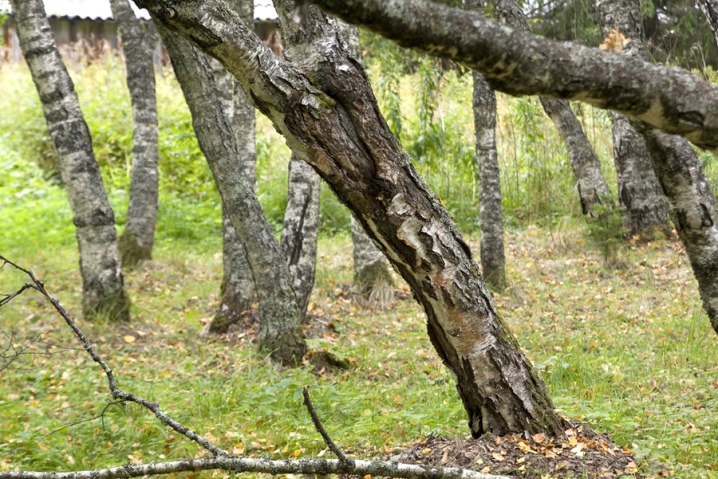
Planting and leaving
Breeding of Karelian birch is the patrimony of nurseries at research institutes. Growing this species on your own is not easy. There is no guarantee whether there will be thoroughbred shoots that sprout from seeds. There are statistics according to which patterning will persist in no more than a third of cases. That is, only 30% of healthy trees that emerge will have a unique wood pattern. The rest of the trees will grow as ordinary hanging birches.
If it is decided to plant, this should be done in spring or autumn. The composition of the soil is not so important, but there should be enough light for the tree. Therefore, the best place for Karelian birch will be an open area.
When digging holes for seedlings, you need to adhere to this rule - they should be one and a half times larger than the root system of a young tree. Planting in the ground can be accompanied by the introduction of rotted compost, mullein or leaf humus. Urea or ammonium nitrate is also added. When planting is complete, the tree needs to be watered abundantly.
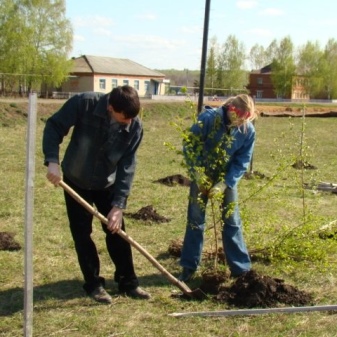
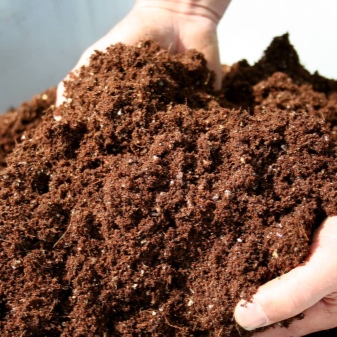
Care features:
- the first years are very important protect birch from drying out, as soon as the heat burst out - the tree needs to be watered;
- in order for water to be better preserved in the ground, the trunks should be mulch - peat, needles, ordinary sawdust will do for this;
- a couple of times a season in the soil you need make complex mineral fertilizersthat will stimulate the growth of birch;
- and here you do not need to shape a haircut, if this is done, the crown will recover slowly;
- if prune, then only sick or already dead shoots and only in the spring, until the sap flow begins;
- where the shoots had to be cut off, the wound needs to be treated garden pitch.
No special winter care and protection is required. Cold and roots, and the trunk will endure calmly.
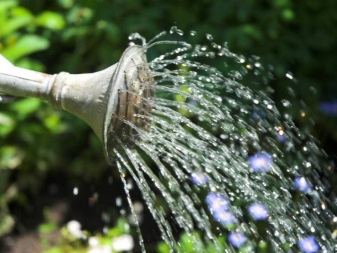
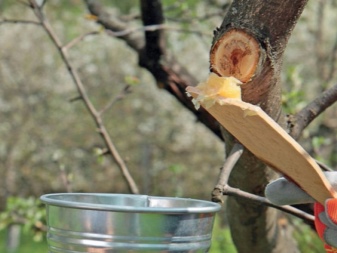
Reproduction
Poaching felling caused a lot of damage to the Karelian birch. I had to connect dendrologists. For almost 90 years, a rare species of birch has been cultivated artificially. And the largest plantings of the Karelian beauty were sheltered by the Kivach reserve.
You can breed a plant.
- By seed method - this option is used mainly in nurseries. Specialists keep pollination and maturation under control. Even before planting, the seeds are stored in the cold for three months. Seeds are sown in open ground, grounding them by a meter and a half. There are approximately 1 g of seeds per square meter. The sprouts that have risen must be dived.
- Vegetative way - this option is good because it predicts the patterning of trees to a greater extent. For grafting, take green cuttings from the top of the crowns. Cuttings are prepared in the midst of spring. The material is grafted into the split on the stumps of old trees, it is also possible for the bark. Open sections will have to be covered with plasticine. Wrapping will also work.
Cuttings of Karelian birch will not take root on their own. Reproduction by layering will be effective. Adult plants that are at least 15 years old are used for this.
Usually trees preparing for felling fall under this case.
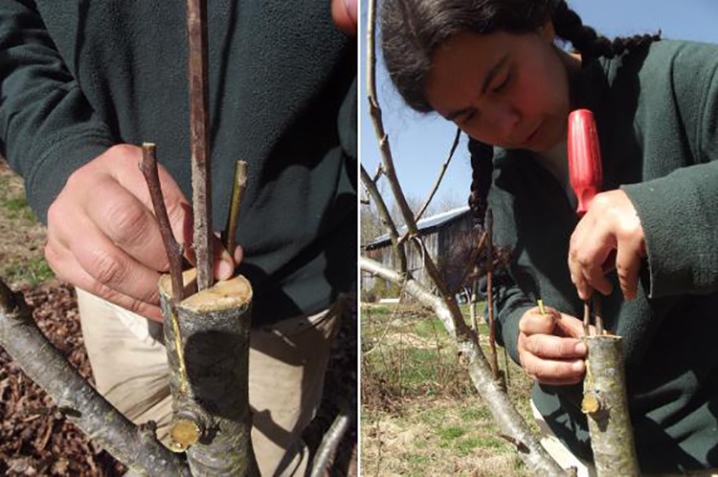
How to distinguish from the usual?
It is difficult to confuse them, although, given that the Karelian birch also has its own varieties, a mistake is not excluded.
What is the difference between Karelian birch and drooping birch:
- marble cut pattern - but this difference can be noticed only by carefully examining the wood inside, a saw cut of a tree, for example;
- branched, rather curved trunk - this is the surest sign;
- the trunk of the Karelian birch is covered characteristic influxes and bumps;
- inside the tree is strongly twisted, wood fibers are directed to the cut plane at different angles;
- the wood itself is light, but the blotches that create the pattern are dark.
Finally, Karelian birch cannot be found in the depths of the forest. But along the lake shores, it grows more willingly.
The first years of its life, a young tree is not much different from an ordinary birch, its characteristic features are formed later, after at least 10 years.
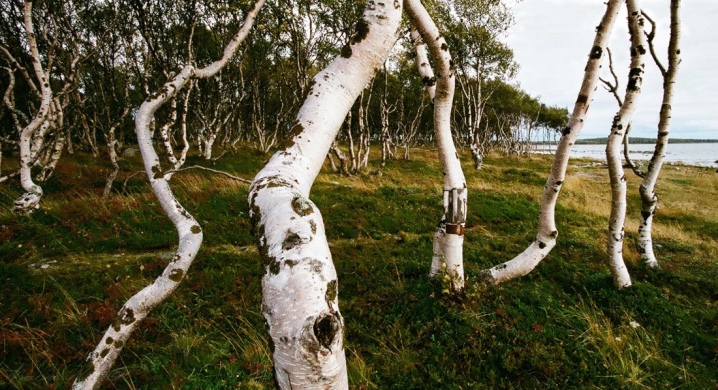
Where is it used?
In 1917, the Faberge brand made an Easter egg from Karelian birch wood - it was an imperial order. Since then, more than one generation has been able to evaluate the decorativeness of wood, but today they are trying to preserve the valuable material, that is, to reduce the felling.
This wood was highly appreciated as an ornamental material. The very unique wood pattern, more like marble, in handicrafts (boxes, souvenirs) will really decorate the interior. Karelian birch furniture will be a chic, valuable purchase. Musical instruments made from this wood look luxurious.Interior decoration of buildings with Karelian birch is also possible, although such repairs are very expensive.
Today, very little furniture is made from valuable wood. - the tree becomes rare, you need to save it, therefore active felling, which requires furniture production, are not carried out... But Karelian birch veneer is used - this can be called a compromise solution.
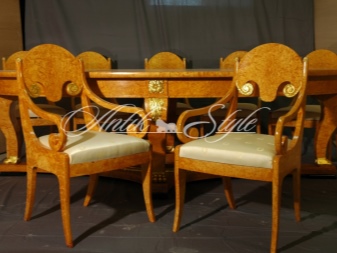
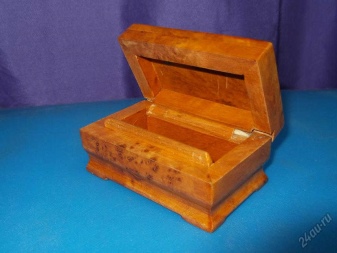
What products are in demand:
- knife handles - they will give odds to various boho products, as well as the production of Scandinavian brands, because they look both natural and not entirely familiar;
- countertops - a Karelian birch table will be a luxurious purchase, if it is veneer, it is easier to find such furniture;
- caskets - do not need special decoration, since the material is aesthetically self-sufficient;
- billiard cues - connoisseurs of the game will appreciate the convenient, reliable and beautiful tool.
By the way, the wood of this tree is also unique in that it is the only material in the world that is measured not in cubic meters, but in kilograms. Everyone is accustomed to the volume of the forest, but the Karelian birch requires a special attitude.

Sometimes you can find bars of Karelian birch on the market: craftsmen buy them and make small products themselves - the same knife handles, jewelry, fishing accessories. Such a block will be a valuable find.
Unfortunately, such unusual trees are considered rare today. Regarding common birch, this is not an exaggeration at all. And although artificial cultivation of the species is underway, it would be wrong to rely only on it.... This is not an easy task, and it is not always successful. That is why dendrologists urge to preserve natural growths, to preserve them, wisely using wood in industry.
Of course, after cutting, cutting, drying, processing, beautiful products are obtained, but in order for other generations to see them, it is necessary to preserve and restore existing products from Karelian birch.
Many lovers of natural decor find furniture and souvenirs through the Internet, boxes from a Karelian beauty, transform them, prolonging their life.




































































The comment was sent successfully.